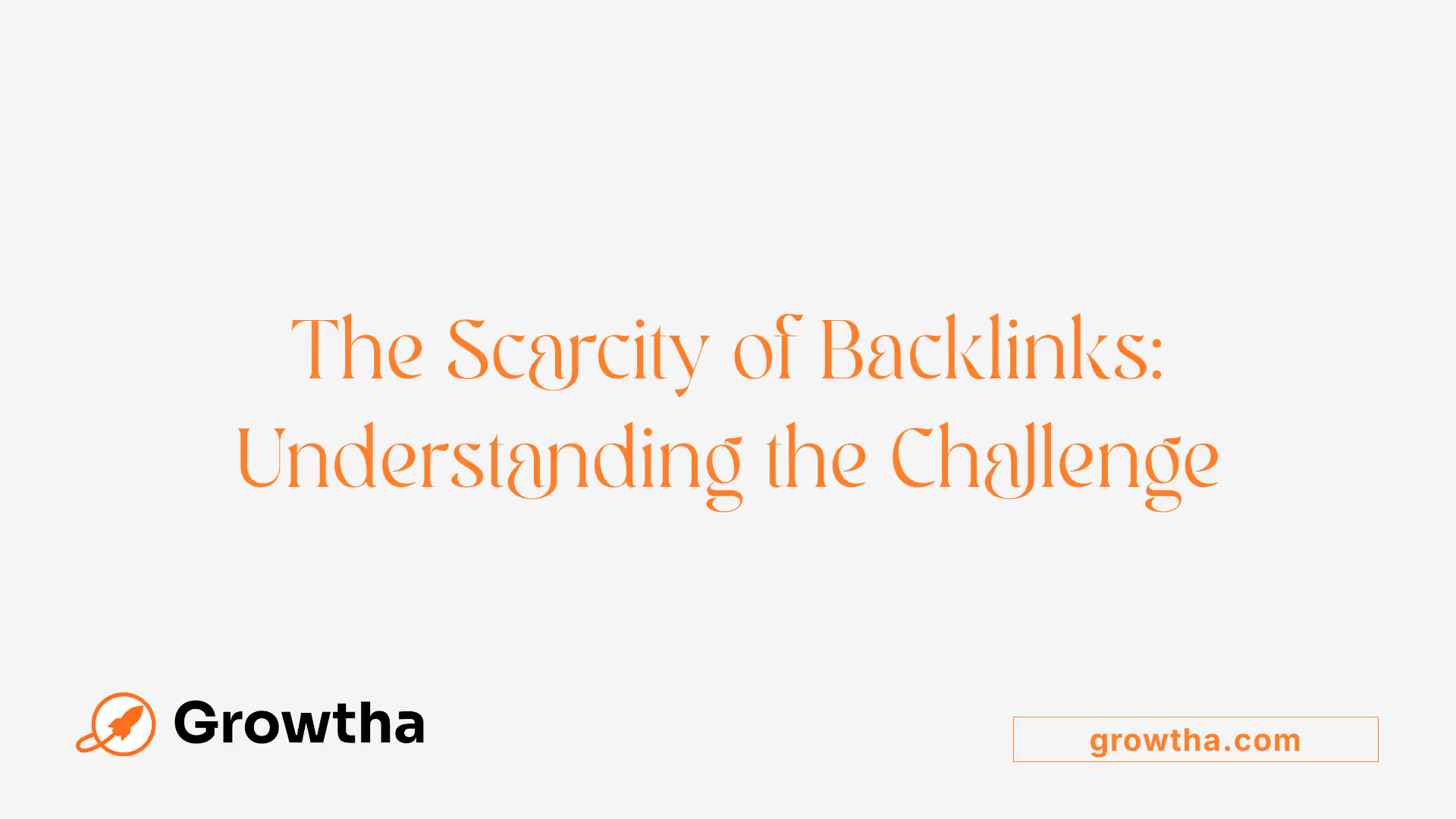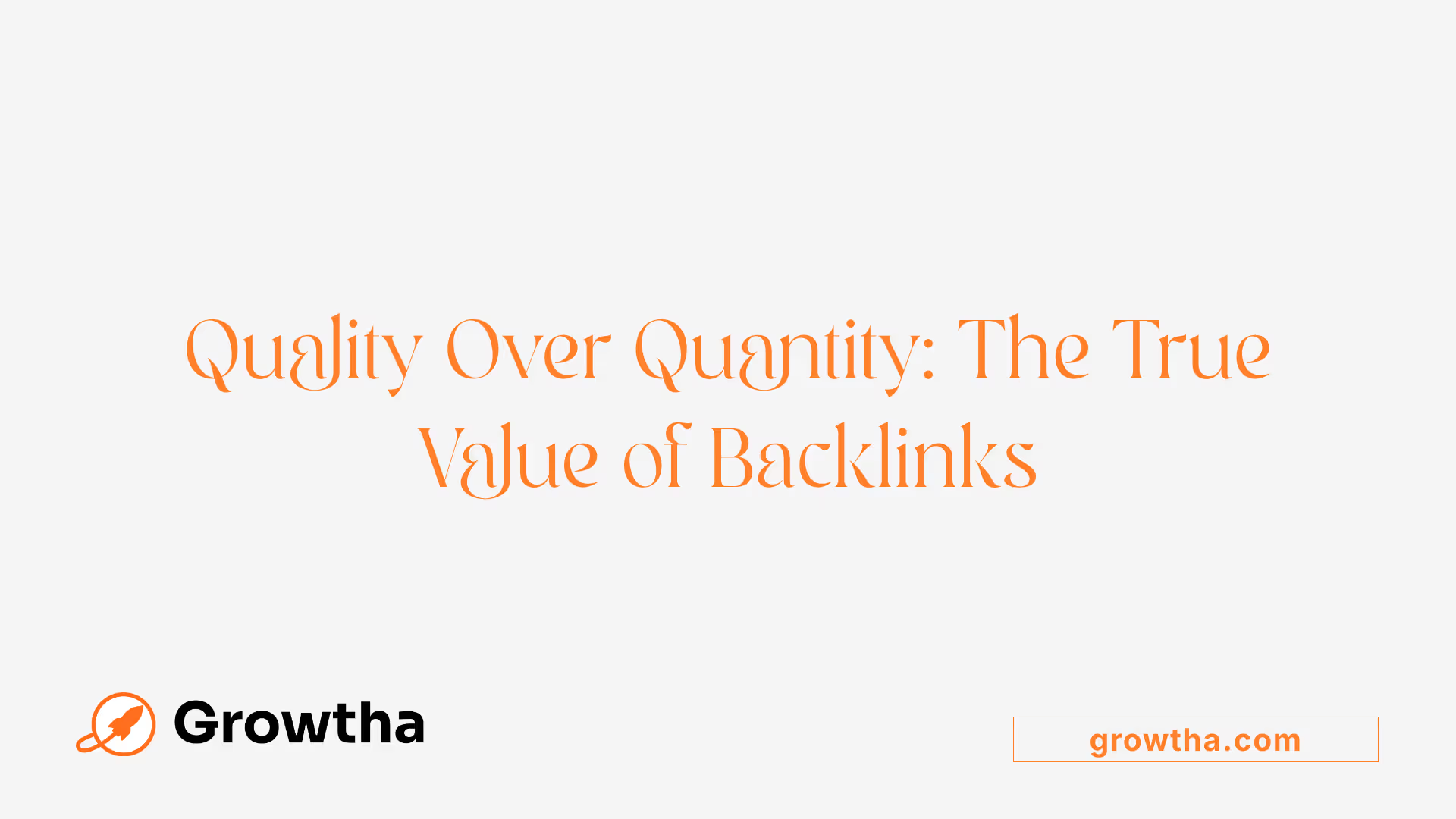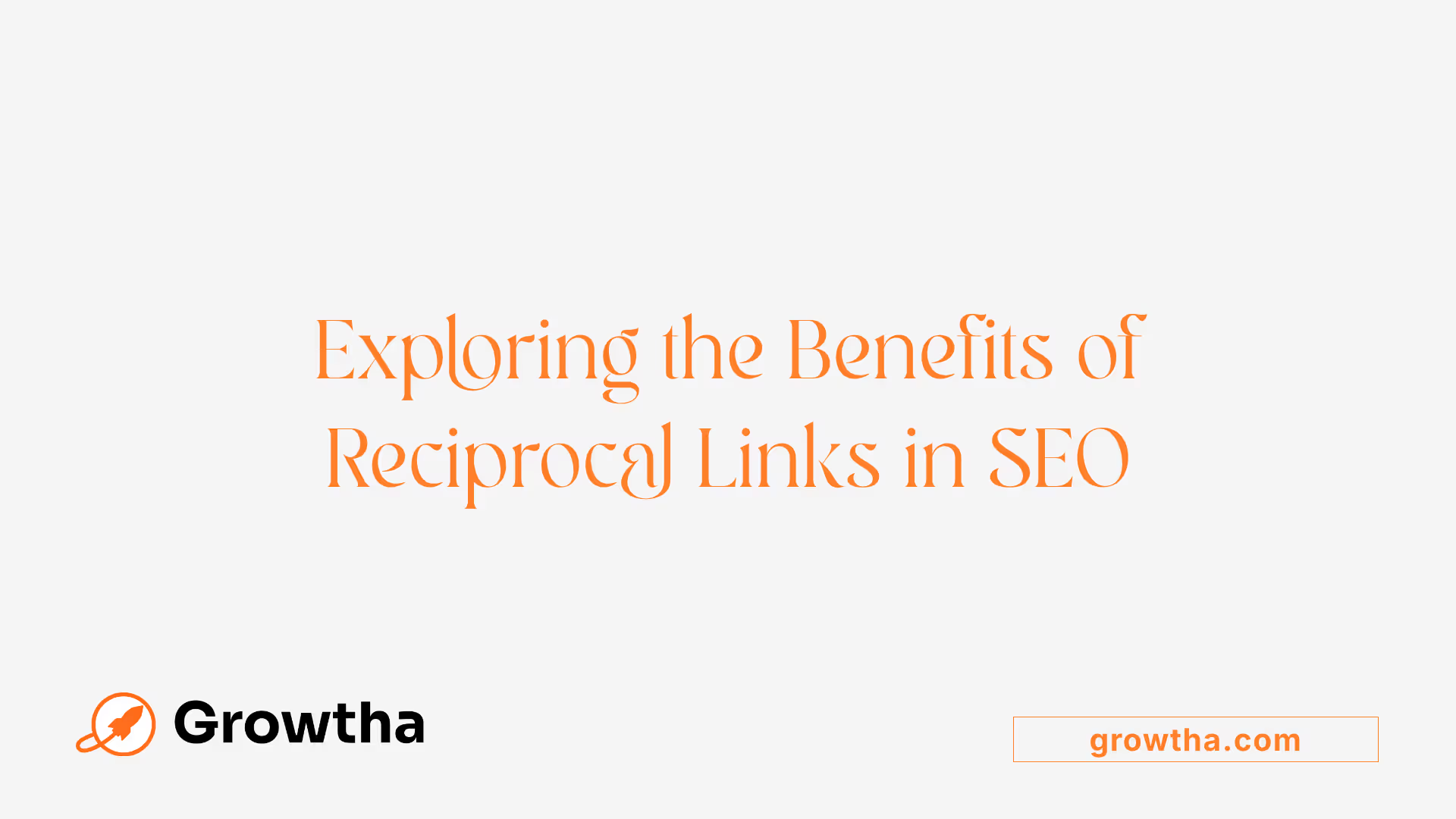8 Backlink Statistics: How Links Influence SEO Rankings
Research indicates a strong correlation between the number of backlinks and Google Search rankings.


8 Backlink Statistics: How Links Influence SEO Rankings
The Power of Backlinks in Modern SEO Strategy
Understanding Backlink Influence
In the ever-evolving world of SEO, backlinks remain a pivotal factor in determining search engine rankings. With vast data underscoring their importance, it is crucial for marketers and SEOs to grasp the latest statistics and trends surrounding backlinks. This article explores eight significant backlink statistics that highlight their impact on SEO rankings and provides insights into optimizing link-building strategies.
1. The Impact of Backlink Quantity on Rankings

How do backlinks contribute to SEO success in 2024?
Backlinks play a crucial role in SEO success in 2024, functioning as a vote of trust by search engines that can significantly elevate a website's authority. Research indicates a strong correlation between the number of backlinks and Google Search rankings; notably, the top-ranking pages boast 3.8 times more backlinks than those ranked lower. This disparity emphasizes the competitive advantage that a robust backlink profile provides in search results. According to a study by Ahrefs, 95% of pages have zero backlinks, illustrating the challenges many face in gaining visibility. Quality is prioritized over quantity, with 93.8% of marketers acknowledging that a single link from a high-authority site holds more value than multiple links from lesser-quality domains.
Among the prevailing strategies, Digital PR has emerged as a favored link-building approach, utilized by 67.3% of marketers. This method allows brands to generate high-quality backlinks through media coverage and online publications. Furthermore, guest posting remains popular, adopted by 38.9% of marketers, providing opportunities to place links within valuable content. As SEO evolves, 53% of digital marketers regard backlinks as vital for the future of search engine optimization. This highlights their enduring significance as a top ranking factor.
The consistent pursuit of high-authority domains and the cultivation of valuable content continues to be fundamental in effective link-building strategies. As search algorithms become increasingly sophisticated, the emphasis on links that reflect relevance and authority is more vital than ever. In essence, fostering quality backlinks is paramount to understanding the changing landscape of SEO and improving a site's visibility.
2. The Scarcity of Backlinks Among Web Pages

What are backlinks and how do they affect SEO?
Backlinks are links from one website to another and are essential for search engine optimization (SEO) as they act as 'votes of confidence' for a website, indicating value and credibility. Search engines reward sites with high-quality backlinks, which can significantly influence their ranking in search results. The quality and authority of the linking websites matter; backlinks from sites with high Domain Authority (DA) are more beneficial than those from lesser-known sites. Effective strategies for obtaining backlinks include guest blogging, creating shareable content, and community involvement. Overall, a robust backlink profile can enhance a website's visibility, drive organic traffic, and improve its overall SEO performance.
Percentage of pages without backlinks
The statistics surrounding backlinks present a stark picture of the competitive nature of link building. Data from multiple sources indicates that a considerable majority of websites are struggling to establish these crucial connections. Specifically, 93.8% of online pages receive no external links, and around 66% of web pages have no backlinks at all. This underscores the challenges many sites face in acquiring links that can bolster their visibility in search results. Only 5% of websites online benefit from backlinks, emphasizing that gaining backlinks is often an uphill battle. In the context of SEO, where backlinks are a top-ranking factor for Google, this scarcity highlights both the importance and difficulty of effective link building in improving search engine rankings.
Challenges in link building
Link building is particularly challenging, with 52.3% of digital marketers identifying it as the hardest aspect of search engine optimization. The effort required to create a successful link-building strategy often necessitates significant time and resources. On average, SEOs spend 1-2 hours to build a single link, and results from link-building initiatives typically take around 3 months to manifest. 79.7% of SEOs acknowledge that link building forms a crucial part of their SEO strategy, yet 40% prioritize it above other practices. These challenges reflect the ongoing need for innovative strategies in a field that is increasingly recognizing the lasting impact of backlinks.
Link Building Statistics
Statistic Value Importance Percentage of pages with zero backlinks 95% Highlights widespread scarcity of backlinks Total percentage of pages without any links 93.8% Indicates drastic challenges in link acquisition Experts who find link building challenging 52.3% Shows need for strategic focus in SEO efforts
3. The Correlation Between Long-Form Content and Backlinks

How Does Long-Form Content Affect Backlink Acquisition?
Research consistently shows that long-form content, typically defined as articles containing at least 3,000 words, attracts significantly more backlinks than its shorter counterparts. According to recent studies, long articles receive an average of 77.2% more backlinks when compared to shorter pieces. This trend underscores a compelling relationship between content depth and the propensity for external sites to link back to a page.
Moreover, these findings align with the general principle in search engine optimization that quality content is crucial for building authority. A study by Ahrefs revealed that pages with a substantial amount of informative content not only enhance user experience but also receive increased attention from other content creators looking to reference or support data found in long-length articles. These backlinks can be integral in boosting a site's organic visibility on search engines.
The implication is clear: businesses and content marketers aiming to improve their search rankings should consider investing time and resources into developing robust, long-form articles that can serve as valuable linkable assets. A commitment to quality and thoroughness in content creation fosters an environment ripe for backlink acquisition, ultimately enhancing the website’s overall authority and performance in search rankings.
Statistics on Long-Form Content Backlinks
Statistic Percentage/Value Source Long articles (3,000+ words) receive more backlinks 77.2% Backlinko 0.44% of links use 'rel=ugc' 0.44% Ahrefs 95% of published web pages lack backlinks 95% Ahrefs
4. Backlink Quality: More Than Just Numbers

Why does backlink quality matter?
Backlinks are not merely about quantity; their quality can significantly impact a website's search engine ranking and overall authority. Ahrefs indicates that more than 66% of web pages lack any backlinks, illustrating a saturated landscape where only a few succeed in securing quality links. Furthermore, 93.8% of link builders affirm that quality is more important than quantity, reinforcing the notion that a single high-quality link from an authoritative source can outweigh numerous low-quality ones. Backlinks serve as a 'vote' of trust for search engines, influencing a page's credibility and ranking. Websites boasting a higher Ahrefs/Moz/SEMrush Domain Rating are more likely to rank well in search results, highlighting the essential relationship between link quality and search performance.
Understanding Domain Authority in Backlinks
Domain authority (DA) plays a pivotal role in assessing the quality of backlinks. 65% of marketers assert that DA is paramount, often considering it more significant than the sheer number of links. This perspective reveals a foundational truth in SEO: not all backlinks are created equal. A link from a site with high domain authority can propel a webpage's rankings more effectively than numerous links from lesser-known sites. Moreover, backlinks from domains with established reputations in relevant niches offer a competitive advantage, enhancing both organic traffic and visibility. In a landscape where 95% of pages have no backlinks, understanding and prioritizing the quality of link building can distinguish successful SEO strategies from those that flounder.
Link Quality Versus Link Quantity
Metric Quantity Quality Backlinked Pages 95% have none Focus on high-quality sources Link Builder Priorities 6% prioritize quantity 93.8% prioritize quality DA Importance All backlinks counted Links from high DA sites favored
5. The Role of Reciprocal Links in SEO

What is Reciprocal Linking?
Reciprocal linking, often termed link exchange, occurs when two websites link to each other. This practice can enhance a site’s credibility and visibility, as search engine algorithms consider backlinks as endorsements of a site's content. According to Ahrefs, 43.7% of top-ranking pages in Google utilize reciprocal links, suggesting this approach can effectively contribute to improved rankings. Despite its benefits, it's crucial for webmasters to focus on high-quality sites for these exchanges, as links from higher authority domains yield greater SEO benefits.
Is Reciprocal Linking Effective for Search Rankings?
The effectiveness of reciprocal links in improving search rankings is notable. Ahrefs indicates a direct correlation between the number of backlinks, including reciprocal ones, and a website's ranking position. In fact, only 5% of all websites possess backlinks, and among those that do, 66% engage in reciprocal linking strategies, showcasing its pervasiveness in SEO practices. The top-ranking pages tend to gain 5% to 14.5% more dofollow backlinks each month, often bolstered by interlinking strategies. This proves that as websites build out their backlink profiles through mutual linking, they can not only enhance their rankings but also establish stronger networks that are beneficial for visibility and overall traffic.
Reciprocal Links Summary
Statistic Percentage Implication Top-ranking pages using reciprocal links 43.7% Suggests strong correlation with improved rankings. Web pages with no backlinks 95% Indicates vast competition and the need for backlink strategies. Websites engaged in reciprocal links 66% Demonstrates popularity as an SEO practice.
6. The Economic Aspect of Backlink Acquisition
What are the Costs Involved in Backlink Acquisition?
The price of acquiring backlinks can vary widely based on several factors, including the quality of the links and the methods used to build them. On average, professionals are seeking to pay approximately $361.44 for individual paid backlinks. This figure reflects a significant monetary commitment many businesses are willing to make to enhance their SEO effectiveness. High-end links, often associated with reputable sites, can cost even more, often exceeding $1,000 each. Furthermore, the average price for a guest post is $220, while the insertion of a link onto an existing piece can cost around $141.
How Common are Paid Link Strategies?
According to recent studies, a staggering 74.3% of link builders resort to paying for links, underscoring this method's prevalence within the digital marketing industry. This trend shows that many marketers recognize the challenges in organic link acquisition due to the competitive nature of SEO, where 95% of all pages online lack any backlinks. Alluding to the difficulties faced, 65% of marketers see link building as the most challenging part of SEO, indicating that financial investments in backlink acquisition have become commonplace.
What is the ROI of Paid Backlinks?
The return on investment (ROI) for paid links tends to be a complex topic. While many marketers report worthwhile returns from their link building efforts, the average impact of paid links is often modest, yielding only an additional two links per month. This limited increase raises questions regarding the overall effectiveness of purely paid strategies, as 89% of marketers still emphasize the need for high-quality content to naturally attract backlinks. Ultimately, the financial commitment towards link building strategies must be balanced with the reality that acquiring backlinks is not a guaranteed path to higher search rankings.
7. The Influence of Social Media on Link Building
How Does Social Media Impact Backlink Acquisition?
Social media is increasingly recognized as a vital tool in the link building strategy for many marketers. A study indicates that link builders using social media build 22% more links compared to those who don’t engage with platforms like Twitter, Facebook, and LinkedIn. This reflects the expanding role of social media in distributing content and generating interest among potential backlink sources. The mechanism is straightforward: sharing content across various social platforms not only amplifies reach but also enhances the likelihood that others will notice and link to that content. As digital PR gains traction, a significant number of marketers—67.3%—consider such approaches as the most effective link-building tactic, integrating social media into their broader strategies.
The Role of Content in Social Media Link Building
Furthermore, the production of high-quality content remains central to successful link acquisition. In fact, 89% of marketers produce content specifically to build links, emphasizing that compelling narratives and well-crafted articles can drive both social sharing and backlink generation. Especially with long-form content—defined as articles exceeding 3,000 words—receiving an average of 77.2% more backlinks than shorter pieces, the quality and length of content shared on social media are pivotal. This alongside the improved visibility stemming from social media promotions creates a robust cycle of content dissemination that enhances the chances of attracting valuable backlinks.
An Overview of Findings
Insight Statistic/Percentage Source Link Builders Using Social Media 22% More Links Authority Hacker Marketers Producing Content for Links 89% Various Studies Impact of Long-form Content 77.2% More Backlinks Backlinko
8. The Lifespan and Relevance of Backlinks
What is the prevalence of dead links?
A striking 66.5% of links created in recent years are now considered dead, which signifies a major challenge in the link building process. Additionally, a staggering 95% of all web pages currently lack any backlinks, further illustrating the competitive landscape of SEO. This high prevalence of dead links, alongside the overwhelming number of pages without active backlinks, underscores the importance of continuously monitoring and maintaining backlink strategies. Part of the reason for such a high percentage of dead links includes factors like crawl errors and pages being dropped or moved without redirection. A well-maintained backlink profile is crucial for ensuring that sites retain traffic and authority in a constantly shifting digital environment.
How do dead links impact SEO?
The presence of dead links can significantly erode a site's search engine optimization efforts. When backlinks decay, they can result in a loss of link equity, meaning that any SEO value once passed through those links is effectively lost. Furthermore, sites with many dead backlinks may experience declining search rankings, as search engines assess a site's relevance and authority based on the quality and quantity of its inbound links. In this competitive landscape, effective link management not only aids in sustaining rankings but also helps in improving overall user experience – a prime factor in retaining visibility in search results. As experts project that backlinks will continue to hold weight in Google's ranking algorithm, ensuring the longevity of these vital links should remain a priority for digital marketers.
Summary of Link Decay and Its Impact
Metric Percentage Significance Web pages with zero backlinks 95% Indicates the scarcity of backlinks across the web. Proportion of dead links since 9 years ago 66.5% Reflects the challenges of maintaining quality backlinks. Impact of dead links on SEO High Negative influence on rankings and authority.
SEO Success in 2024: Key Statistics
What are the latest statistics for SEO success in 2024?
The latest statistics for SEO success in 2024 emphasize the critical role of organic search, with organic results accounting for 45.1% of all clicks. Notably, zero-click searches represent 25.6% of search queries, highlighting the increasing trend of users not navigating beyond the search results. Featured snippets are extremely important, boasting a clickthrough rate of 42.9%, while the top organic search result captures 39.8% of all clicks, reinforcing the importance of ranking high. With over 99,000 Google searches occurring every second and 92.3% of users accessing the internet via mobile, it is vital for websites to optimize for mobile and search visibility. Additionally, 68% of online experiences begin with a search engine, illustrating the foundational nature of search in user navigation.
Understanding the Impact of Backlinks on SEO
A study from Backlinko highlights that the number of domains linking to a page is the strongest indicator of its ranking in Google search results. This statistic is further illustrated by the staggering fact that 66% of pages have zero backlinks, underscoring the competitive landscape of link building. Pages that adopt long-form content, defined as texts exceeding 3,000 words, receive an average of 77.2% more backlinks than shorter articles, demonstrating that quality and comprehensive content attracts more links. Notably, the top-ranking page enjoys 3.8 times more backlinks than those ranked 2-10, reaffirming the significant correlation between backlinks and higher search engine rankings. Additionally, 94% of web pages on the internet have no external links pointing to them, which reflects the uphill battle many face in acquiring backlinks, yet continues to highlight the potency backlinks have in enhancing site authority and driving traffic.
Backlinks: An Ongoing SEO Priority
In 2024, 40% of SEO experts prioritize backlinks as their top concern, recognizing their essential role in digital marketing strategies. The report indicates an ongoing belief that backlinks will maintain their significance for SEO effectiveness, with 89% of marketers stating that link quality outweighs quantity. Furthermore, websites with high-quality backlinks derived from sources such as digital PR and guest posting strategies experience substantial benefits, correlating directly with improved brand authority and organic traffic. As competition intensifies, many marketers allocate substantial resources to link building, with approximately 40% of businesses spending between $1,000 and $5,000 monthly on this strategy. This commitment reflects an understanding that effective link acquisition is fundamental for achieving desired visibility in the competitive search landscape.
Key Link Building Statistics for 2024
Statistic Value Significance Percentage of pages with zero backlinks 94% Indicates significant challenge for online visibility. Average backlinks of top-ranking pages over lower ones 3.8 times Demonstrates the strong link between number of backlinks and ranking. Proportion of marketers prioritizing backlinks 40% Highlights the continued focus on link building in SEO strategies. Percentage of SEO experts believing in link impact 67.5% Shows the widespread acknowledgment of backlinks' role in SEO.
Starting Points for Online Experiences
Why Are Backlinks Crucial for SEO?
Backlinks act as endorsements that signal to search engines the credibility and relevance of a webpage. According to Google, backlinks are one of its top three ranking factors, emphasizing their role in determining search engine rankings. Statistics reveal a strong correlation between the volume of backlinks and organic traffic: the top-ranking page on Google has an average of 3.8 times more backlinks than those in positions 2-10. This implies that effective link building strategies can enhance visibility significantly.
What Challenges Do Websites Face in Building Backlinks?
Approximately 66% of websites online have no backlinks pointing to them at all. This statistic reflects a competitive landscape where many pages struggle to obtain valuable links that boost visibility. Moreover, 94% of online content does not receive external links, which adds to this challenge. Many SEO professionals recognize the difficulties, with 65% claiming that link building is the hardest part of their SEO efforts. Strategies such as digital PR and guest posting have emerged as effective tactics to counter these challenges, yet still, the majority of websites find it hard to generate organic traffic due to a lack of incoming backlinks.
What Trends Are Shaping Link Building Strategies?
In the evolving landscape of SEO, long-form content is increasingly recognized for its potential in attracting backlinks. On average, content pieces exceeding 3,000 words receive 77.2% more backlinks than shorter articles. This trend highlights the importance of creating detailed, quality content that serves the target audience while simultaneously enhancing link-building opportunities. As the majority of marketers—89%—aim to create content for the purpose of generating links, quality content creation remains a central link acquisition strategy in the SEO arsenal.
Link Building Statistics
Statistic Percentage Source Pages with no backlinks 66% Ahrefs Link building is the hardest part of SEO 65% uSERP Content 3000+ words getting more backlinks 77.2% Backlinko
Harnessing the Power of Backlinks for Optimal SEO
The evidence is clear: backlinks remain a cornerstone of effective SEO strategies. By understanding the statistics surrounding backlink acquisition and trends, SEO professionals can craft more robust plans that enhance web presence and search rankings. Emphasizing quality over quantity, leveraging long-form content, and integrating social media are all part of a comprehensive approach that ensures backlinks serve their fundamental role in driving organic traffic and establishing domain authority. As we look to the future, continuing to adapt to the dynamics of link building and backlink management will be essential for sustained digital success.
References
- 74 Important SEO Statistics for 2024 - Backlinko
- 124 SEO Statistics for 2024 - Ahrefs
- Link Building Statistics That Prove You Need To Build Links
- 60 SEO Statistics & Trends For 2024 – Forbes Advisor
- Top 31 Link Building Statistics & Facts on Backlinks for SEO (2024)
- 71 Link Building Statistics [Improve Your 2024 SEO Strategy]
- 28 Link Building Statistics For 2024: Improve Your SEO Strategy
- 40 Link Building Statistics and Trends to Know for 2024 - uSERP







